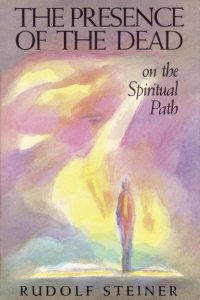
In these lectures Rudolf Steiner deals with the relationships people as
spiritual beings who live in the physical world have with those who have
crossed the threshold and live in the spiritual world. He shows how an
understanding of our spiritual nature reveals possibilities of knowing the
world that are denied by materialism.
The tone of these lectures, which deal with examples drawn from Steiner's
own experience and the lives of those now dead who were personally known to
him — Robert Hamerling, Maria von Strauch-Spettini, Christian
Morgenstern, and Oda Waller — is unusually warm and moving.
Seven lectures held in various cities between April 17 and May 26, 1914.
From the volume,
How Does One Gain Understanding of the Spiritual World?
It is translated by Christian von Arnim and edited by Joachim Reuter.
This book is a translation of
Wie erwirbt man sich Verständnis für die geistige Welt?
Das Einfliessen Geistiger Impuls aus der Welt der Verstorbenen.
(volume 154 in the Collected Works), published by Rudolf Steiner Verlag,
Dornach, Switzerland, 1985.
| I. | Understanding the Spiritual World I |
April 18, 1914 |
| The nature of dreaming.
Hallucination. Etheric substance and increased strength of soul. The
esoteric script. Ordinary and super-sensible thinking. The ancient
founders of the religions and modern spiritual science of the
spirit. The nature of Christ. More about dreaming. The nature of the
astral body. The image of the I as the focus of experiences in the
spiritual world. Atavistic clairvoyance and healthy judgment. Clear
thinking as the precondition for spiritual science. |
| II. | Understanding the Spiritual World II |
May 12, 1914 |
| Johann Gottlieb Fichte's
relationship to the spiritual world and to his human environment.
The distinction between physical and spiritual perception. The
destiny of a friend (Maria von Strauch-Spettini) and her elevation
to guardian spirit of the Mystery Dramas. The deceased friend and
poet (Christian Morgenstern) and his nature in the life after death.
The depiction of the Dornach building in the press. The formation of
judgment on the basis of spiritual science. |
| III. | Awakening Spiritual Thoughts |
May 05, 1914 |
| About sleep. The contrast
between blood and nervous system and the rest of the organism in
sleep. Germs and ghosts. The nature of germs. Spiritual thoughts as
food for the dead. Overcoming egotism with regard to the dead. About
the death of a friend (Christian Morgenstern): The founders of the
religions and their significance. Modern mankind comes of age. The
deed of Christ. The nature of the physical world. The premise
underlying the Dornach building. Developing the thinking processes
as the task of our times. The expulsion of a member and the reasons
for this action. |
| IV. | The Presence of the Dead in our Life |
May 25, 1914 |
| Clairvoyant consciousness and dreaming.
The difference between the form and the action of the deceased.
Acquiring new concepts to understand the spiritual world. A
deceased individual (Maria von Strauch-Spettini) as protector
of the Mystery Drama performances. Joan of Arc. Experiencing the
angels (mildness) and the archangels (strength). The character
of a friend and poet (Christian Morgenstern) after death. The
experience of the spiritual world. Angels, archangels, Lucifer
and Ahriman. The transformation of experiences in the physical
and the spiritual world. The enrichment of thinking. The Dornach
building. The essence of the anthroposophical movement. The
inauguration of the building. |
| V. | The Blessing of the Dead |
May 26, 1914 |
| Spiritual science as
“spiritual chemistry.” Concentration and meditation.
Perception of the inner word. Illusion and self-knowledge. The
nature of encounters with the deceased. Inspiration of Rudolf
Steiner's feeling and will through a deceased friend (Oda Waller).
Thinking becomes independent. The enhancement of logical thinking
through clairvoyant knowledge. The concordance between intelligence
and clairvoyance. The spatial and temporal firmament. Giordano Bruno
and spiritual science break through these firmaments. The limits of
knowledge and their refutation. Spiritual science as synthesis of
science, intellect, and clairvoyant research. |
| Appendix |
| The following two lectures differ in character and content from the preceding five.
In both, Rudolf Steiner approaches the central theme from a much wider perspective.
In addition, “Faith and Knowledge” is not a complete, word for word, record of a lecture but notes summarizing
what Steiner said. Therefore, the two lectures have been placed in the appendix. | |
| VI. | Faith and Knowledge |
April 17, 1914 |
| The great founders of the religions
and their task. Thinking that consumes and thinking that nourishes.
The “I believe” of earlier times and the “I
believe what I know” of today. Max Müller's statement
about the divine proclamation. Human beings as illuminating beings
after death. The significance of myths and fairy tales in life.
Meeting with two priests. The process of seeing. Dead and living
ideas. The saying “a healthy soul in a healthy body.”
The notion that our senses perceive only oscillations and
vibrations. Midsummer and Easter. |
| VII. | Robert Hamerling: Poet and Thinker
|
April 26, 1914 |


